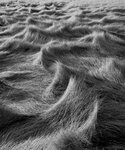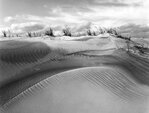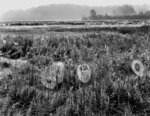




A BOOK ARRIVED at The Cricket earlier this winter. It was large and handsome. Inside was a universe — black and white photographs of the Great Marsh, ghostly, intimate, and impossibly still. Liminal in every way, land and sea, black and white, real and unreal — like a memory or a dream. The images were breathtaking.
Between Land and Sea, The Great Marsh, is the work of fine art photographer Dorothy Kerper Monnelly. Dorothy has spent over forty years photographing the Ipswich salt marsh, a tiny piece of the 20,000-acre Great Marsh.
First published in 2006, and again in 2020, the book chronicles the wild natural landscape of the Ipswich marsh. Using her large format black and white camera with a 4x5 negative, Dorothy reveals the marsh and its endless wonders, cloud patterns, ice patterns, sand patterns and what she calls “little perfections.”
Dorothy’s love of photography began with her father’s enthusiasm for images. Dorothy’s mother, a poet, died from breast cancer when Dorothy was only eight. Raised by her beloved father, a radiologist and amateur photographer, she speaks with great fondness of his dashing out of the darkroom to have a look at an image and then dashing back in to adjust it. To Dorothy, it seemed thrilling. She inherited his camera and, it would seem, his passion.
Dorothy began shooting with her father’s old large format camera before moving on to her own. She is entirely self-taught using the Ansel Adams zone system, an exposure method using 10 brightness values. She got seriously into dark room work in her late twenties, explaining that by the time a print is finished it is a “history of decisions.”
In her early thirties, Dorothy and her husband moved to the town of Ipswich, drawn to Crane beach and the stunning natural surroundings. Little did she know that what she describes as her “best friend,” the one that would inspire her for the next forty years, was waiting for her. The family settled into a tightly knit community that has been supportive and a source of great joy to Dorothy this day. Once she got the kids off to school, she would carry her large camera, tripod and gear deep into the marsh. She would spend day after day on the marsh. Watching. Waiting. And learning. She explains that she just could not stop. Returning again and again revealed a depth and an understanding that she found irresistible.
Over time this has given her a fluency with the marsh.
When I first arrived at Dorothy’s home, I got out of my car and turned to find, quite unexpectedly, an enormous pond in which, gliding along, were a pair of mated swans. The scene was so exquisite, so serene and unusual, that I momentarily lost myself in it and stood for quite some time, just watching. I felt instant peace. Finally knocking on the door, and meeting Dorothy in person, I was not at all surprised to find that she evokes precisely the same feeling. At 84 she is remarkably spry, with mesmerizing blue eyes, and a quiet kindness and curiosity. Dorothy’s work is stacked and piled throughout the tidy house. She is currently involved in five shows, a comment on the significance of her work.
Dorothy’s large format silver gelatin prints are in the permanent collection of the National Museum of Women in the Arts in Washington, D.C. and are also held in several major museum collections nationwide. In 2012 her Ice Pattern Series was exhibited at Photo Vernissage in St. Petersburg, Russia. She showed her photographs throughout the country from 2013 through 2017 with photographers Ansel Adams and Ernest Brooks ll. The show, entitled “Fragile Waters”, was conceived in 2013 by Jeanne Adams in response to the BP oil spill, and highlights the significance of water in its many forms and locations. In June, 2021, several of her photographs will be shown in “Vital Waters,” opening in Pueblo, Colorado.
Following the publication of Between Land and Sea, Dorothy was diagnosed with breast cancer, just like her mother. This diagnosis led to her decision to organize and publish her mother’s poetry. She envisioned a book that paired her photography with her mother’s poems. She decided this would be a message, a gift, to all daughters. Her idea was met with a small amount of resistance, but Dorothy was steadfast. For My Daughters, published in 2012, is Dorothy’s favorite book.
Dorothy knows all about the swans. She has been watching them. She shows me where their nest is. She also tells me about the shy female cardinal outside the window, and the discouraged squirrel, and the little chickadee that chatters to her when she refills one of her many bird feeders. She is in a community of nature. The house is surrounded by burgeoning spring flowers. A large vegetable garden sits expectantly in the front pasture. The longer I am there, the more I notice the constant activity surrounding her home. It becomes clear that she has earned the trust of all of these creatures. They, in turn, choose to share their very special lives with her. Perhaps her relationship with the marsh is not so very different.
We walk together out onto the marsh to a spot where several of her images were taken. Dorothy speaks about her relationship to the marsh, about how it feels when she is working here. She uses the word “disappears”. She is so connected to the marsh that she is able to simply dissolve into it. To see it from within. The “inner eye.” Dorothy describes it as her soul connecting with the landscape. Merging with it in a way that is an inner experience. The limitation of place, and the limitations of black and white, like a silent movie, or eating with your eyes closed, leads to an expansiveness. A depth that you would otherwise never be able to experience.
At the end of our walk, Dorothy offered me a glass of water back at her house. When we pulled into the drive, she noted that her husband was home. Her voice sparkled, and so did her blue eyes, as she turned to me to say, “He is the most extraordinary man. One in a million.” They have been married for fifty-two years. This led me to think about the swans, her father, her mother’s poetry, and her relationship with the marsh — it was all connected.
I have been thinking a lot lately about love. And I realize that what we feel in the images Dorothy has captured is just this. All this time Dorothy has been quietly, patiently, falling in love with the marsh and it, in turn, has revealed to her parts of itself hidden to those of us who cannot see. The parts revealed only when you are — in love. This is ultimately the greatness of Dorothy’s work, and I would argue — of her life. “Love is the key that lets one in.”
Between Land and Sea, The Great Marsh by D.K. Monnelly is available at the independent book store, Manchester By The Book, Union Street, Manchester.